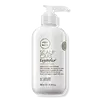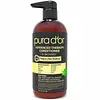What's inside
What's inside
 Key Ingredients
Key Ingredients

 Benefits
Benefits

 Concerns
Concerns

 Ingredients Side-by-side
Ingredients Side-by-side

Water
Skin ConditioningCetyl Alcohol
EmollientStearyl Alcohol
EmollientCetearyl Alcohol
EmollientOleyl Alcohol
EmollientStearamidopropyl Dimethylamine
EmulsifyingMelaleuca Alternifolia Leaf Oil
AntioxidantTrifolium Pratense Flower Extract
AstringentPyridoxine Hcl
Skin ConditioningRosmarinus Officinalis Leaf Extract
AntimicrobialPanax Ginseng Root Extract
EmollientCurcuma Longa Root Extract
MaskingPisum Sativum Peptide
Skin ConditioningTerminalia Ferdinandiana Fruit Extract
AntioxidantLeuconostoc/Radish Root Ferment Filtrate
AntimicrobialDicetyldimonium Chloride
EmulsifyingGlyceryl Stearate
EmollientAmodimethicone/Morpholinomethyl Silsesquioxane Copolymer
Propylene Glycol
HumectantHydroxyethylcellulose
Emulsion StabilisingTrideceth-5
EmulsifyingDisodium EDTA
Citric Acid
BufferingGlycerin
HumectantMyristyl Alcohol
EmollientMagnesium Nitrate
Cetrimonium Chloride
AntimicrobialPhenoxyethanol
PreservativeMethylchloroisothiazolinone
PreservativeMethylisothiazolinone
PreservativeCI 16035
Cosmetic ColorantCaramel
Cosmetic ColorantParfum
MaskingLinalool
PerfumingGeraniol
PerfumingWater, Cetyl Alcohol, Stearyl Alcohol, Cetearyl Alcohol, Oleyl Alcohol, Stearamidopropyl Dimethylamine, Melaleuca Alternifolia Leaf Oil, Trifolium Pratense Flower Extract, Pyridoxine Hcl, Rosmarinus Officinalis Leaf Extract, Panax Ginseng Root Extract, Curcuma Longa Root Extract, Pisum Sativum Peptide, Terminalia Ferdinandiana Fruit Extract, Leuconostoc/Radish Root Ferment Filtrate, Dicetyldimonium Chloride, Glyceryl Stearate, Amodimethicone/Morpholinomethyl Silsesquioxane Copolymer, Propylene Glycol, Hydroxyethylcellulose, Trideceth-5, Disodium EDTA, Citric Acid, Glycerin, Myristyl Alcohol, Magnesium Nitrate, Cetrimonium Chloride, Phenoxyethanol, Methylchloroisothiazolinone, Methylisothiazolinone, CI 16035, Caramel, Parfum, Linalool, Geraniol
Aloe Barbadensis Leaf Juice
Skin ConditioningPolyquaternium-81
CleansingEthylhexyl Olivate
Skin ConditioningSqualane
EmollientCetearyl Alcohol
EmollientPyrus Malus Fruit Extract
Skin ConditioningGlycerin
HumectantStearamidopropyl Dimethylamine
EmulsifyingStearyl Alcohol
EmollientArgania Spinosa Kernel Oil
EmollientHelianthus Annuus Extract
EmollientTocopherol
AntioxidantLactobacillus Ferment
Skin ConditioningPropanediol
SolventCucurbita Pepo Seed Extract
Skin ConditioningLonicera Caprifolium Flower Extract
PerfumingLonicera Japonica Flower Extract
Skin ConditioningHydroxyethylcellulose
Emulsion StabilisingOryza Sativa Bran Extract
Skin ConditioningRosmarinus Officinalis Leaf Oil
MaskingCucumis Sativus Extract
Skin ConditioningPersea Gratissima Fruit Extract
EmollientAloe Barbadensis Leaf Juice, Polyquaternium-81, Ethylhexyl Olivate, Squalane, Cetearyl Alcohol, Pyrus Malus Fruit Extract, Glycerin, Stearamidopropyl Dimethylamine, Stearyl Alcohol, Argania Spinosa Kernel Oil, Helianthus Annuus Extract, Tocopherol, Lactobacillus Ferment, Propanediol, Cucurbita Pepo Seed Extract, Lonicera Caprifolium Flower Extract, Lonicera Japonica Flower Extract, Hydroxyethylcellulose, Oryza Sativa Bran Extract, Rosmarinus Officinalis Leaf Oil, Cucumis Sativus Extract, Persea Gratissima Fruit Extract
 Reviews
Reviews

Ingredients Explained
These ingredients are found in both products.
Ingredients higher up in an ingredient list are typically present in a larger amount.
Cetearyl alcohol is a mixture of two fatty alcohols: cetyl alcohol and stearyl alcohol. It is mainly used as an emulsifier. Emulsifiers help prevent the separation of oils and products. Due to its composition, it can also be used to thicken a product or help create foam.
Cetearyl alcohol is an emollient. Emollients help soothe and hydrate the skin by trapping moisture.
Studies show Cetearyl alcohol is non-toxic and non-irritating. The FDA allows products labeled "alcohol-free" to have fatty alcohols.
This ingredient is usually derived from plant oils such as palm, vegetable, or coconut oils. There is debate on whether this ingredient will cause acne.
Due to the fatty acid base, this ingredient may not be Malassezia folliculitis safe.
Learn more about Cetearyl AlcoholGlycerin is already naturally found in your skin. It helps moisturize and protect your skin.
A study from 2016 found glycerin to be more effective as a humectant than AHAs and hyaluronic acid.
As a humectant, it helps the skin stay hydrated by pulling moisture to your skin. The low molecular weight of glycerin allows it to pull moisture into the deeper layers of your skin.
Hydrated skin improves your skin barrier; Your skin barrier helps protect against irritants and bacteria.
Glycerin has also been found to have antimicrobial and antiviral properties. Due to these properties, glycerin is often used in wound and burn treatments.
In cosmetics, glycerin is usually derived from plants such as soybean or palm. However, it can also be sourced from animals, such as tallow or animal fat.
This ingredient is organic, colorless, odorless, and non-toxic.
Glycerin is the name for this ingredient in American English. British English uses Glycerol/Glycerine.
Learn more about GlycerinHydroxyethylcellulose is used to improve the texture of products. It is created from a chemical reaction involving ethylene oxide and alkali-cellulose. Cellulose is a sugar found in plant cell walls and help give plants structure.
This ingredient helps stabilize products by preventing ingredients from separating. It can also help thicken the texture of a product.
This ingredient can also be found in pill medicines to help our bodies digest other ingredients.
Learn more about HydroxyethylcelluloseWe don't have a description for Stearamidopropyl Dimethylamine yet.
Stearyl Alcohol is a type of fatty alcohol from stearic acid. It is a white, waxy compound used to emulsify ingredients.
Fatty Alcohols are most often used as an emollient or to thicken a product. Emollients help soothe and hydrate the skin by trapping moisture.
They are usually derived from natural fats and oils and therefore do not have the same drying or irritating effect as solvent alcohols. FDA allows products labeled "alcohol-free" to have fatty alcohols.
Learn more about Stearyl Alcohol